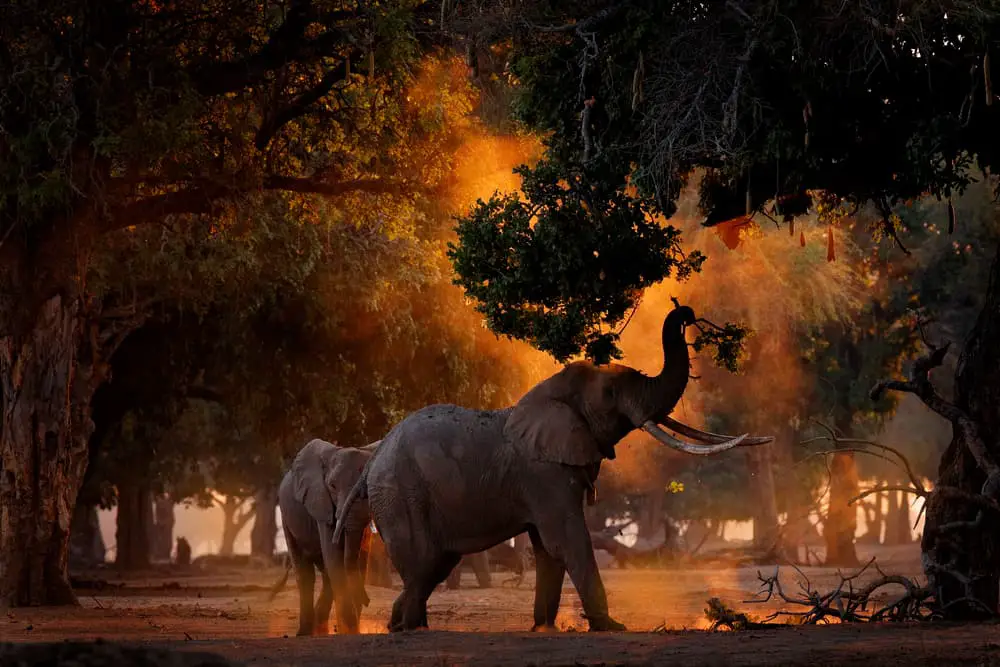
Africa is the second-largest continent in the world and has been credited with the birthplace of humanity. Our ties to Africa are ancient and none more than the link to its forests. In literature, pop culture, exploration, and wonder, the deep enchanted forests of the Congo are what we picture when we think of Africa. But, what other types of forests do we find on the continent?
According to the United Nations Food and Agriculture Organization, approximately 22.7% of Africa is covered in forests. These forests are divided between “Tropical” and “Temperate.” Forests biomes are located in Sub-Saharan Africa, with the greatest biomass in West and Central Africa.
Although the overarching categories of forests are limited to tropical and temperate, local environmental conditions shape the formation of these forests to create some interesting varieties and diversity.
Table of Contents
- A Guide To The Types Of Forests Found In Africa
- Conclusion
A Guide To The Types Of Forests Found In Africa
A forest, according to Britannica, is a “complex ecological system in which trees are the dominant life-form.”
Although forests vary greatly in terms of plant and animal composition, certain factors remain the same.
For a tree-dominated forest to exist, the mean summer temperature must be above 50 °F, with a minimal annual rainfall of 8 inches.
There are three broad categories of forests found globally. These are Tropical, Temperate, and Boreal.
Africa’s Forests fall into either tropical rainforests or temperate broad-leaved forests.
- Tropical Rainforests include those found along the Equator.
They receive high amounts of rainfall (79 to 394 inches) annually, have an average daily temperature of between 68°F and 77°F, and are frost-free.
- Temperate Broad-leaved Forests (also called Temperate Rainforests) are found south of the Equator (between 25° and 50° latitude).
These forests are characterized by canopy cover that is more or less continuous and comprises broad-leaved, evergreen, or deciduous trees.
These areas usually experience mild winters in temperature, which are nearly frost-free; rainfall of around 59 inches and temperatures of between 37 and 73°F.
The most effective methods of differentiating and discriminating between different types of forests are the species present, the canopy density, parent geology, latitudinal location, and local soil types found.
Tropical Rainforests In Africa
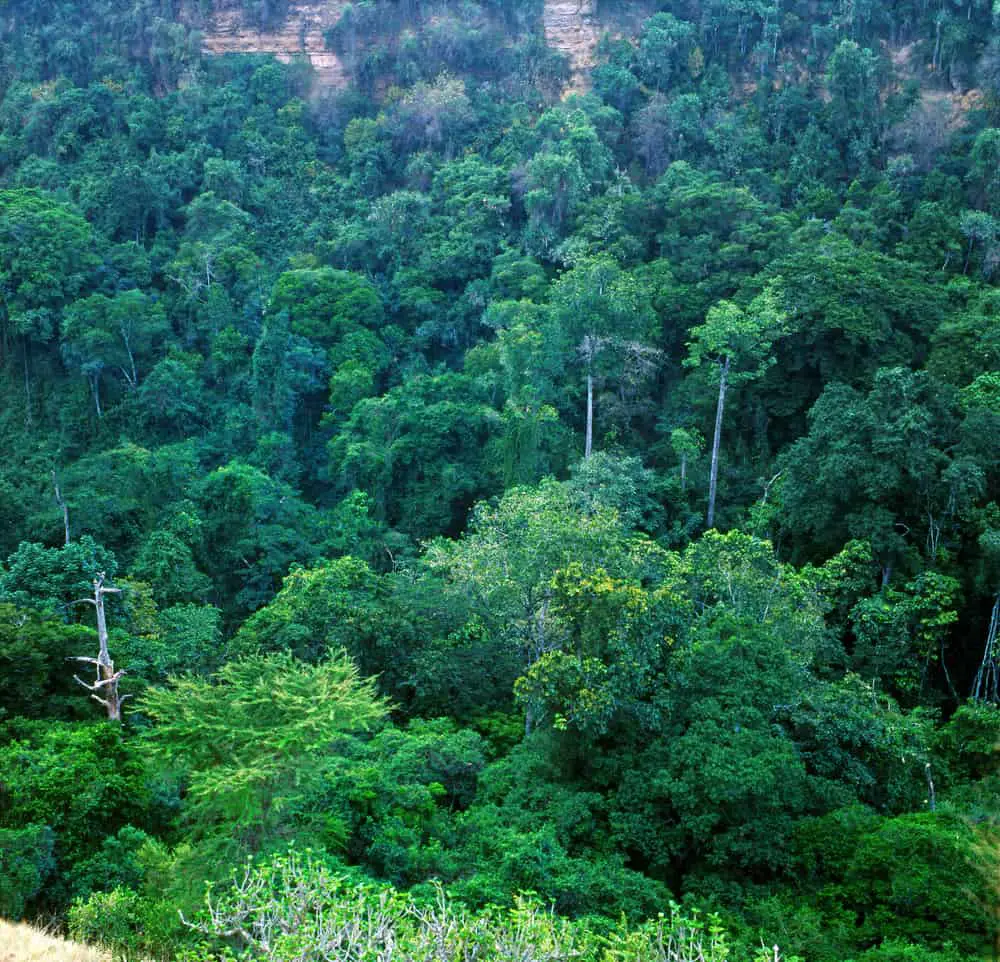
Tropical rainforests are the type of forests that come to mind when we mention a rainforest (Think of Tarzan swinging through the trees on vines!).
These rainforests are found in areas close to the Equator, between the tropic of Cancer and Capricorn.
Tropical rainforests are characterized by their hot, wet conditions.
Seasonal variations do not influence factors such as day length, light penetration, precipitation, and humidity.
Due to these environmental conditions, vegetation grows incredibly well and forms three different layers or strata. These are:
- The canopy– The tops of trees can often reach heights of around 250feet and more!
This densely growing layer greedily absorbs the majority of sunlight, preventing the lower stories from receiving much-if any.
Woven into these treetops are thick woody vines.
- The understory– This is the middle layer comprising of smaller trees, ferns, palms, and vines. These trees have adapted to low levels of sunlight due to the oppressive canopy.
- The floor of a tropical rainforest is low in primary production but high in nutrient recycling.
Few plants can grow here due to the shortage of light; however, fungi, lichens, and other detritivores thrive in these warm, wet conditions, where they decompose the leaf litter that builds up from the trees above.
In total Tropical rainforests cover an estimated 8 895 793 732acres of Africa.
Where they are located:
- West Africa: Côte d’Ivoire, Gabon, Ghana, Guinea, Liberia, Nigeria, Sierra Leone
- Central Africa: Democratic Republic of Congo, Cameroon, Central African Republic, Equatorial Guinea, Republic of Congo
- East Africa: Ethiopia, Kenya, South Sudan, Uganda
- Southern Africa: Angola, Madagascar, Mozambique, Tanzania, Zambia
Examples Of Tropical Rainforests In Africa: The Congo Rainforest And Guinean Forests
- The Congo Rainforest (or Congo River basin) is the second-largest tropical rainforest globally and is critically important in terms of species diversity, carbon sinks, ecological processes, and livelihoods.
It comprises six different countries’ forests (Cameroon, the Central African Republic, the Democratic Republic of Congo, Equatorial Guinea, Gabon, and the Republic of Congo).
The Congo Rainforest and its Basin region comprise a total area of approximately 500 million acres.
- The Guinean Forest is divided into two sub-regions.
The upper sub-region, from the west, stretches from Guinea, through Sierra Leone, Liberia, Côte d’Ivoire, Ghana, Togo, and Benin.
The lower sub-region stretches from southern Nigeria into southwestern Cameroon, São Tomé and Príncipe. The offshore islands of Equatorial Guinea also comprise this sub-region.
The entire region of the Guinean Rainforest is believed to be comprised of approximately 51 million acres.
Fauna And Flora Of The Congolian And Guinean Rainforests
Congo Rainforest
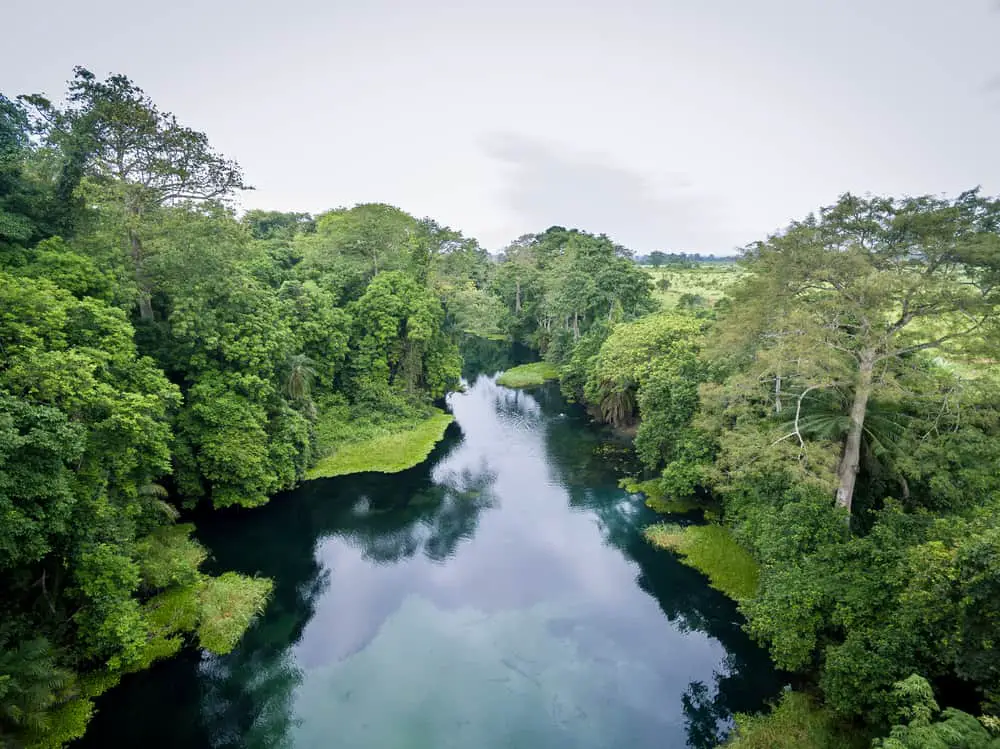
Fauna
The Congo is renowned for its diversity of animal species. There are approximately 10 000 different species across its range.
Some species located here include:
- Gorillas (lowland and mountain)
- Chimpanzees
- Bonobos
- Okapis
- Leopards
- Forest elephants
- Forest Giraffes
- 400 species of mammals
- 1,000 species of birds
- 700 species of fish
Flora
Within the Congo Rainforest, there are an estimated 600 different species of trees. While the level of tree diversity is low, the size of the trees in both height and diameter are larger than those of their Amazonian counterpart.
Some notable species of tree include:
- Sapele (Entandrophragma cylindricum)
- Kapok tree (Ceiba pentandra)
- Mukulungu (Autranella congolensis)
- Bilinga (Nauclea diderrichii)
- Utile (Entandrophragma utile)
- West African Cedar (Entandrophragma candollei)
- African teak (Pericopsis elata)
There are an estimated 10 000 species of vascular plants, of which around 30% are considered endemic.
Guinean Forest
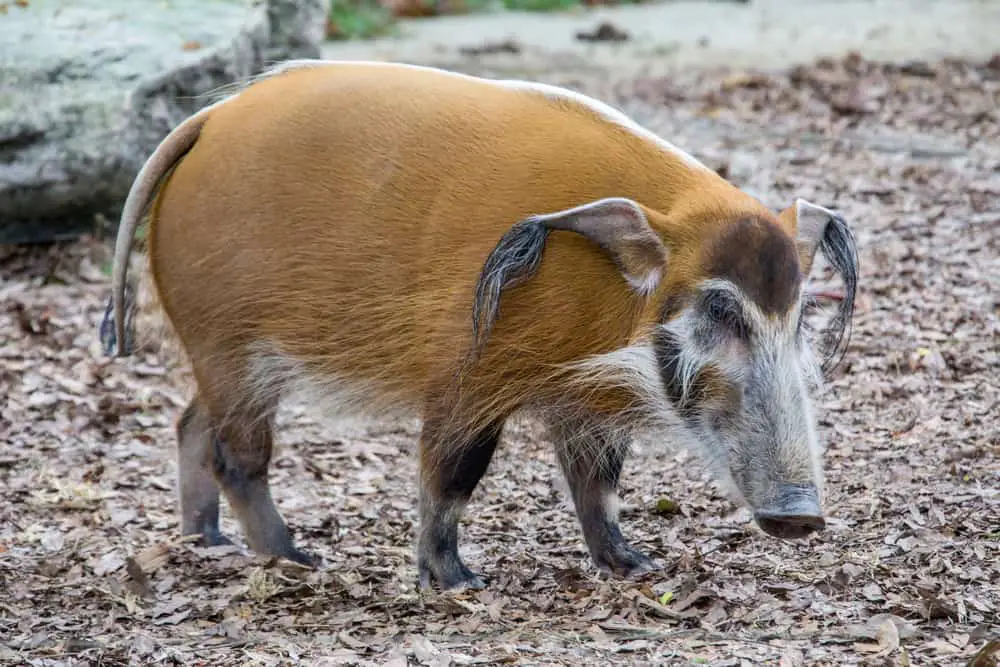
Fauna
The Guinean forest is home to numerous species of different taxa.
These include:
- 416 mammals (65 endemics)
- 917 birds (48 endemics)
- 107 reptiles (20 endemics)
- 269 amphibians (118 endemics)
Flora
Of the around 9000 species of plants (trees, shrubs, and others) that occur in this forest area, there are thought to be about 1800 endemic to the Guinean forest.
Some noteworthy trees include:
- Monkey plum (Dacroydes klaineana)
- súeh (Strombosia glaucescens)
- tallow tree (Allanblackia floribunda)
- African Walnut (Coula edulis)
- African ebony (Diospyros sanza-minika)
Other Interesting Facts About African Tropical Rainforests
- A tribe of pygmies lives in these forests in the Congo Rainforest.
- These rainforests are believed to store more carbon than those in South America.
- It is believed that the “lack” of diversity in tree species and the lower density of smaller trees is due, in part, to the presence of elephants and other large herbivores.
- Many of the plants and animals found in the Guinean forest alone are threatened (936), endangered (21), or even critically endangered (5).
- Many of these tropical forests are used by local communities for timber, cut down to make space for farming, and have their animals and plants collected for food, fuel, and medicine.
Temperate Rainforests In Africa

Temperate rainforests are those forests found outside of the Equator.
The biggest differences between tropical and temperate rainforests are latitudinal distribution, rainfall, and temperature.
Temperate forests also receive high rainfalls, but temperatures are generally lower, especially during the winter months.
There are seasonal differences between summer and winter in these forests in terms of day length, sunlight, and precipitation.
During the colder months, there is a reduction in humidity and precipitation; this leads to some trees losing their leaves and light penetrating to the forest floor.
Often Temperate forests are not found in continuous stretches through Africa.
Instead, they are found in areas that have the correct environmental conditions (rainfall, temperature, soil, and protection from fire).
These forests are also often found along the edges of tropical rain forests as you move further from the Equator towards the coastal regions and their associated cooler climates.
Other Characteristics Of Temperate Forests
Rainfall
Temperate forests occur in regions with more than 20.67inches of rain on average annually for winter rainfall areas and 28.54inches on average annually for summer rainfall areas.
Temperature
Temperate forests occur in regions with no frost, with an average annual temperature of approximately 66.20F.
Altitude
Temperate forests are distributed from sea level to 6890feet and above.
Fire resistance
Unlike the surrounding savanna, these forests do not usually support fire due to high moisture content and humidity. Under severe drought and frequent fires, however, they can burn.
Vegetation
Like a tropical forest, temperate forests have a canopy layer made up of interlocking tree branches, which prevent sunlight from reaching the ground.
The bulk of trees found in these forests are evergreen.
A middle layer or understory is comprised of shorter trees of varying heights.
Ground story plants such as lianas and epiphytes are also a common feature.
Bordering these forests are ecotones, transitional plant communities that form a buffer between forests and the surrounding vegetation types (generally savanna).
Examples Of Temperate Rainforests Found Across Africa
Below are some examples of temperate rainforests found throughout Africa.
Afromontane Rainforests: Characteristics And Examples
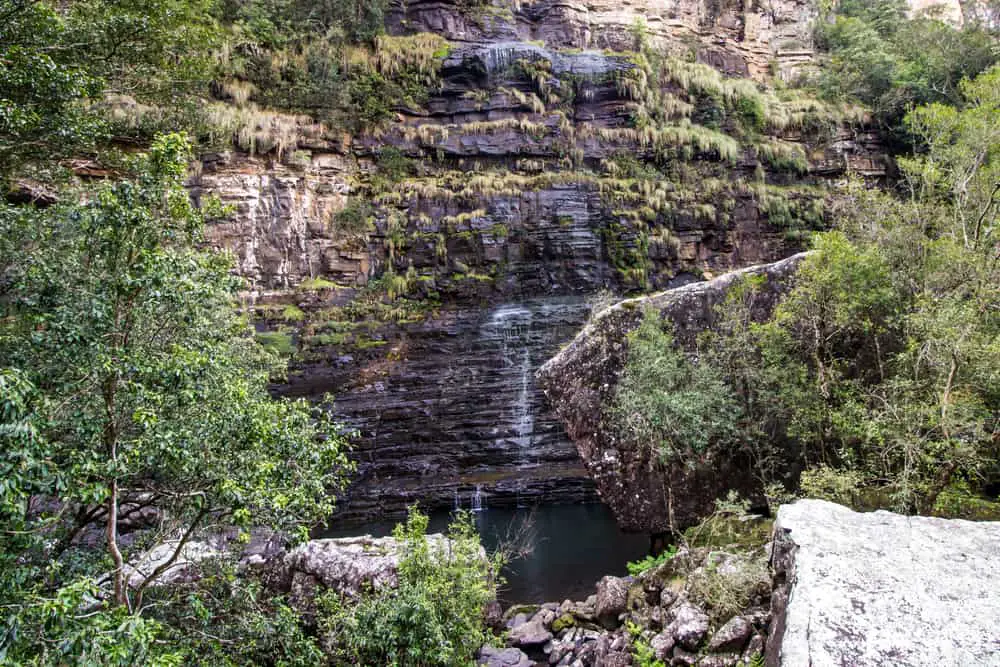
These types of forests are widespread across Africa and include the Eastern Afromontane forest.
Starting up on the Arabian Peninsula, the forest belt moves down through Ethiopia, Tanzania, Malawi, and South Africa.
There are also patches of this forest type in the Congo area and Angola.
Afromontane Forests: Defining Features
Location
These forests are found in mountainous areas. They generally grow on southern facing slopes; they are protected from fire by the rocky terrains.
They can form isolated patches of vegetation in rocky crevices or spread across mountain ranges.
Rainfall
The average rainfall for Afromontane forests is between 49.21 and 98.43inches annually.
Aside from precipitation in the form of rain, many of these forests are also watered by mist, especially during the dry season.
This constant moisture could suggest the reason for less deciduous and more evergreen tree species when compared to the northern hemisphere.
Temperature
Average wet season temperature range: 59.72 and 78.080 F
Average dry season temperature range: 59.9 and 82.580 F
Altitude
These forests are typically found on the African highlands and escarpments, from 3937 to around 8202 feet.
Aspects such as the location of the forest concerning the Equator, nearest ocean, forest size, and underlying geology of the slope that the forest is on will play a role in determining the altitude.
Vegetation
While the growth forms and structure of Afromontane forests are similar to that of tropical forests, the species present is the real determining factor.
Tree ferns (Cyathea spp) and conifer trees (especially Podocarpus spp) are found in Afromantane rainforests.
Prominent tree species include:
- Brown-berry fluted-milkwood (Chrysophyllum gorungosanum)
- Hairy cola (Cola greenwayi)
- South African tree fern (Cyathea dregei)
- Giant diospyros (Diospyros abyssinica)
- River macaranga (Macaranga capensis)
- East African camphorwood (Ocotea usambarensis)
- Real yellow-wood (Podocarpus latifolius)
- African cherry (Prunus africana)
Afromontane Forests: The East African Montane Forest Ecoregion
Location
In total, there are around 25 different patches of forest that make up this ecoregion. Stretching from southern Sudan then moving through Kenya, Uganda, and northern Tanzania, these forests are located on isolated and continuous mountain slopes.
Altitude
The range in altitude is between 3281 and 11483 feet.
Temperature and Rainfall
The lowest winter temperature is around 500F, and the highest summer temperature is 860F.
Rainfall peaks in October to December and again in March to June, with a range of between 47.24 and 78.74inches per annum.
Fauna
Eight species of bird are endemic to this region.
Due to the discontinuity of the forests, many of the animals are isolated and occur only in one or two of the “islands.”
Examples of these include Aberdare cisticola (Cisticola Aberdare), Abbott’s starling (Cinnyricinclus femoralis), and Kenrick’s starling (Poeoptera kenricki).
In terms of mammals, this ecoregion is unable to support endemic large mammal species.
Therefore Black rhinoceros, African forest elephants, and even an isolated population of bongo move between the forest patches.
There are, however, smaller mammals that are endemic.
These include shrews and other rodents (Crocidura gracilipes, Crocidura raineyi, Crocidura ultima, Grammomys Gigas, and Tachyoryctes annectens).
Endemic Reptiles in area number nine and include the montane viper (Vipera hindii), along with six chameleon species.
Amphibians only have two endemic species.
- Flora
It is believed that there is less species diversity in these forests than in tropical forests closer to the Equator.
There are, however, endemic plants found in this ecoregion.
Some important tree species include:
- East African camphorwood (Ocotea usambarensis)
- Arar (Juniperus procera)
- Outeniqua Yellowwood (Podocarpus falcatus)
- Real Yellowwood (P. latifolius)
- common wild elder ( Nuxia congesta)
- Forest newtonia (Newtonia buchananii)
- Size
The total area covered by this ecoregion is 16million acres.
Coastal Forests In Africa: Characteristics And Examples
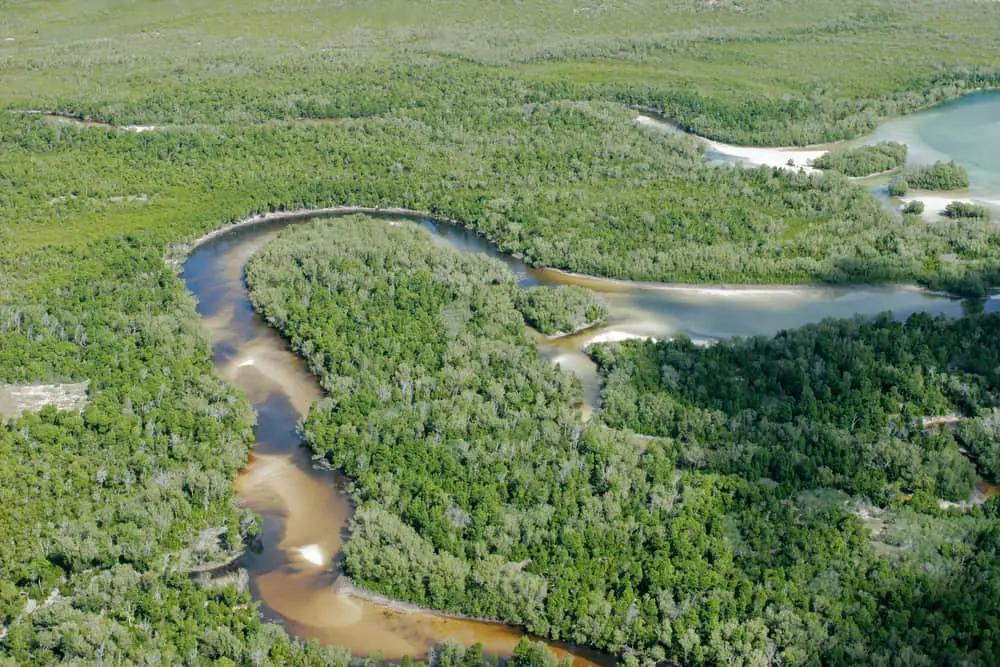
It is sometimes difficult to draw a line between tropical and temperate forests as there are many overlapping features, especially in certain parts of Africa that lie on the Tropic of Capricorn.
This mini-equator region provides a heat and moisture boost to those forests fortunate to be found there.
Coastal forests are some of the more challenging to categorize.
Some of the coastline regions intersect the Equator and the tropic of Capricorn, which results in tropical conditions.
This, coupled with the ocean’s effect in regulating temperatures between summer and winter, results in relatively consistent conditions.
The Coastal Forest Belt stretches along the Indian Ocean coastline from Southern Somalia, down through Kenya, Tanzania, Malawi, across into Zimbabwe, and into Mozambique.
These forests cover a total area of approximately 1222,79 square miles.
This ecoregion is similar to the Afromontane forests of the Eastern Afromontane ecoregion in terms of “isolated islands” or pockets of forest inter-dispersed with settlements and other vegetation.
These forested areas are relatively small, with most being less than 7.72 square miles, with only 19 patches bigger than 11.58 square miles in size.
There are over 200 of these small fragmented forest patches.
What they lack in size these coastal forests make up for in endemic species.
There are approximately 1750 endemic species.
These include 554 endemic plants, six mammals, nine birds, 26 reptiles, two frogs, 79 butterflies, more than 86 snails, and more than 20 millipede species.
The hotspot for these endemics is situated between the Tana River in Kenya and southern Tanzania, while specific forests of concern are:
- lower Tana River
- Arabuko-Sokoke
- Shimba Hills
- lowland East Usambara
- Pugu Hills
- Matumbi Hills
- Rondo
- Litipo
- The island of Pemba
- Bazaruto archipelago
- The forest remnants of Mozambique, Malawi, and eastern Zimbabwe.
This coastal forest is considered to be a relic of past forests that stretched from the Congo basin across most of Central Africa.
The sad reality is, most of these endemic species have a limited range, and most are only found in one or two forest patches.
The foreseeable outcome for most of these species is extinction, as habitat decreases.
Coastal Forests: Defining Characteristics
Temperature
The overarching climate for this coastal forest belt is considered to be tropical. The mean annual temperature is 770F.
Rainfall
There is a high amount of humidity and set wet seasons. However, rain out of season is not uncommon.
In the northern reaches, there are two rainfall periods; first from April to June and secondly during November and December.
While in the southern reaches, rainfall comes once from April to June.
There are drastic fluctuations in rainfall per year, with some years of drought and others of flooding.
Other Examples Forests Found In Africa
Some other forests found across the African continent include
Sand Forests Of Southern Africa
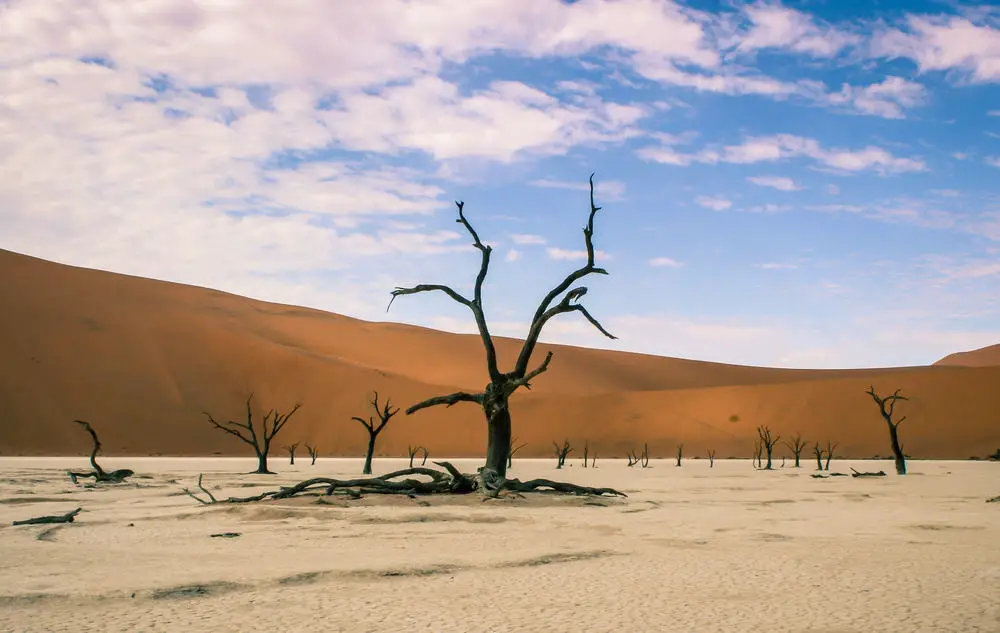
These temperate forests are found in South Africa, especially around the Kwazulu-Natal Province, up into Mozambique.
As the name implies, these forests grow on the sandy soil of ancient dunes.
They are relatively low forests, with Cleistanthus schlechteri, Dialium schlechteri, and Hymenocardia ulmoides forming the closed canopy.
A shrubby understory layer is represented by Croton pseudopulchellus, Pteleopsis myrtifolia, Drypetes arguta, and a ground layer of Eragrostis moggii.
Epiphytic orchids are also present.
Mangrove Forests Of Southern Africa
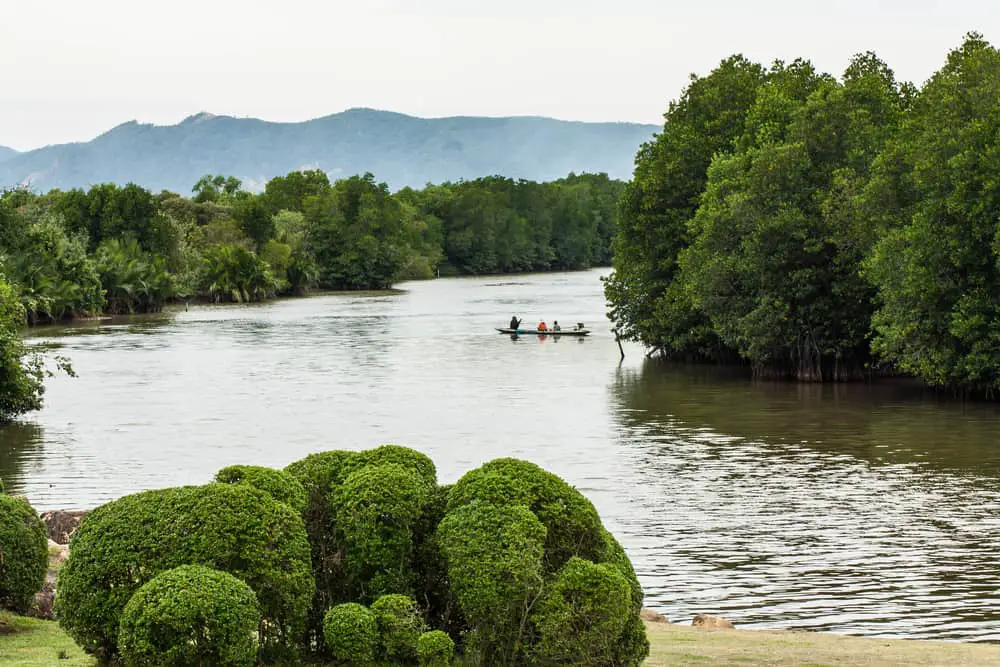
These forests are found stretching from Kwazulu-Natal to the Eastern Cape of South Africa.
They are characterized by low altitudes and are located around coastal estuaries in muddy, waterlogged soils.
These forests often grow in saline, tidal wetlands.
Although mangrove forests are considered poor in species diversity, Raphia australis is a tree that is endemic to this vegetation.
Acrostichum aureum, Avicennia marina, Bruguiera gymnorrhiza are some trees identified with mangrove forests.
Mudskippers, fiddler crabs, and mangrove snails are the associated fauna.
Conclusion
Africa has a representation of both tropical and temperate forests. The bulk of the forest biome is found along the Equator, but resilient pockets of forests in various forms are scattered across the continent. Some of these pockets are slowly becoming relics of past times, while others continue to benefit the animals and people surrounding them.
From food, building materials, and fuel to carbon sinks, we need our forests now more than ever before.
Sources:
National Geographic: Forest Biome
Britannica: Forest
NASA Earth Observatory: Bio Rainforest
Mongabay: Rainforests in Africa
The Conversation: Africa’s rainforests are different. Why it matters that they’re protected
Science Direct: Coastal forests of eastern Africa: status, endemism patterns and their potential causes
Botanical Society: Forests of South Africa
Bird Life International: Africa
World Wildlife: Congo Basin
iNaturalist: Afrotemperate Forest
World Agroforestry Center: Afromontane Rain Forest
World Wildlife: Eastern Africa: Southern Sudan, Central Kenya
One Earth: East African Montane Forests
Research Gate: New information on the Lowland Coastal Forests of Eastern Africa
Department of Water Affairs and Forestry Republic of South Africa: South African Indigenous Forests



